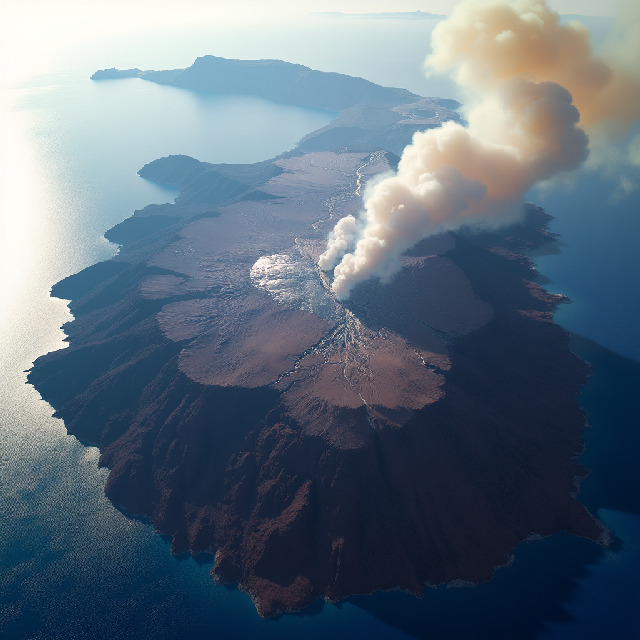Introduction to Santorini Earthquakes: A Comprehensive Overview of the 2025 Seismic Events
In early 2025, the picturesque Greek island of Santorini and its neighboring Aegean islands experienced an unprecedented series of earthquakes. This seismic activity began in late January and intensified throughout February, causing widespread concern among residents, tourists, and scientists alike.
The Earthquakes’ Impact
-
Frequency and Magnitude: Over 300 earthquakes were recorded within a 48-hour period, with magnitudes ranging from minor tremors to more significant quakes exceeding 5.0 on the Richter scale. The strongest earthquake, measuring 5.2 in magnitude, struck on February 6, prompting a state of emergency declaration.
-
Evacuations and Emergency Measures: Faced with the relentless seismic activity, thousands of residents and tourists evacuated the island. Authorities shut down schools, restricted gatherings in enclosed spaces, and deployed emergency services to manage the crisis. Exact evacuation numbers were reported as over 5,000 individuals, highlighting the scale of displacement.
-
Tectonic Context: Santorini lies on the Hellenic Volcanic Arc, a region known for its volcanic and tectonic activity due to the subduction of the African Plate beneath the Aegean Sea Plate. The earthquakes are attributed primarily to tectonic stress rather than volcanic activity, though the presence of an active volcano adds complexity to the situation.
-
Concerns and Uncertainty: Scientists have warned that this swarm of earthquakes could be foreshocks preceding a larger quake. The ongoing seismic activity has raised questions about the stability of Santorini’s volcanic caldera and the potential for future eruptions, although current data suggests no imminent volcanic threat.
Consequences and Response
-
Economic Impact: The tourism industry, a lifeline for Santorini, has been severely disrupted. Economic losses were estimated at over €10 million, with many hotels and businesses reporting cancellations as travelers fled the island.
-
Infrastructure and Safety: Authorities enforced precautionary measures, including restricting traffic and evacuating vulnerable areas to mitigate risks from potential rockslides and structural damage.
-
Scientific Monitoring: Geologists closely monitored the situation using advanced technologies like real-time earthquake detection systems. Early warning systems provided crucial seconds for evacuation and preparation, demonstrating their effectiveness in disaster management.
Emergency Response Measures
Greece demonstrated robust emergency response measures:
- Evacuations by Ferry and Air: Thousands were evacuated using ferries and flights. Airlines added extra flights to assist, ensuring timely relocation.
- School Closures: Schools were closed, with classes moving online to ensure educational continuity while prioritizing student safety.
- State of Emergency Declaration: A state of emergency was declared on February 1, enabling rapid response and resource allocation.
These measures reflected Greece’s commitment to safeguarding its population and managing emergencies efficiently.
Tectonic Activity in the Aegean Sea
The Aegean Sea is a hotspot for seismic activity due to the interaction of several major tectonic plates. Key fault lines include:
- North Anatolian Fault (NAF): A major strike-slip fault responsible for significant earthquakes.
- Hellenic Arc: Features normal faulting due to crustal extension.
- Santorini-Amorgos Fault Zone: Contributed to the recent earthquake swarm.
Volcanic Eruption Concerns
The Minoan eruption around 1600 BCE reshaped Santorini, creating its iconic caldera. Recent seismic activity near the Kolumbo submarine volcano sparked concerns about potential volcanic unrest. Experts emphasize that while an eruption is unlikely, vigilance is crucial given Santorini’s volcanic history.
Scientific Analysis and Predictions
Seismologists use historical data and advanced models to forecast seismic activity. Emerging technologies like AI and early warning systems enhance preparedness. While exact predictions remain elusive, understanding recurrence patterns and leveraging new technologies can mitigate risks.
Human Impact: Stories of Resilience
Evacuations profoundly affected emotional well-being and logistics. Personal stories reveal fear and separation anxiety but also resilience. Community support and technology played key roles in connecting evacuees, highlighting the need for compassionate evacuation planning.
Conclusion
The 2025 Santorini earthquakes underscore the importance of preparedness and scientific research in mitigating natural disasters. By understanding tectonic activity, leveraging technologies, and learning from past events, we can build resilient communities. The interplay between geological threats and human resilience reminds us that knowledge is our best defense against nature’s unpredictability.

How does the article address infrastructure resilience in Santorini’s buildings and hotels amid frequent earthquakes? I’m also interested in whether waste management and recycling efforts by local authorities or businesses are discussed to promote sustainability. Additionally, are there plans for renewable energy projects like solar or wind power to reduce reliance on fossil fuels?
The article overlooks Santorini’s approach to waste management and sustainability during the crisis. I’m curious if recycling programs or similar initiatives supported affected communities and helped preserve the environment.
The article doesn’t discuss Santorini’s infrastructure resilience, waste management, or renewable energy projects. I wonder if they have earthquake-resistant building codes and how they handle sustainability during crises.
I’m curious if the article discusses any sustainable practices or waste management efforts by local authorities in Santorini, offering insights into how they balance emergency response with environmental care. It would be helpful to learn from their approach as a potential model for other tourist destinations facing similar challenges.